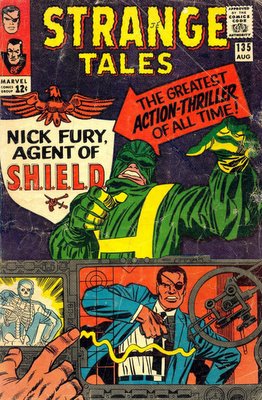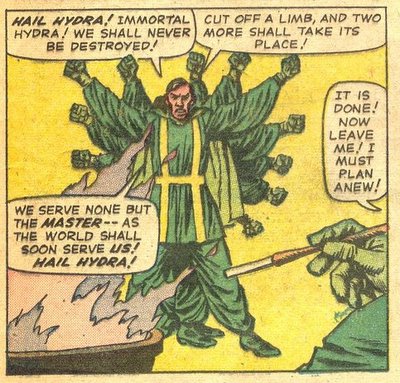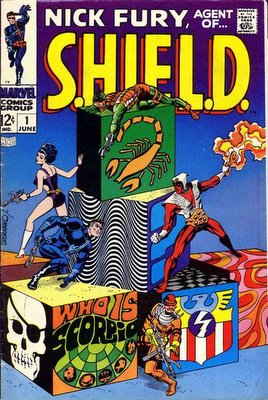As ToS #95 begins, an intruder has gotten into Stark's main plant. Tony's response?

My response would be more along the lines of "An intruder within those walls? What is this, like the 50th time that's happened?" I haven't kept track of it, but I pointed out that between ToS #52 and #63, the only issues that didn't feature an attack on Stark's facilities or one of his weapons were #58 and #62.
We discover who the intruder is here:

Sitwell was an amusing character. On the one hand you can see him as a poke by Lee at the DC Boy Scout heroes, but on the other hand, who was he really mimicking but Stan himself with the "Don't yield! Back SHIELD!" boosterism?
The villain for the issue is the Grey Gargoyle, an old Thor foe who can fly and turn people into stone for one hour. But when he turns Iron Man to stone he decides to kill him by tossing him off the roof of the factory.
In the next issue, we find that Sitwell, despite his rah-rah attitude, knows what to do in an emergency and saves Iron Man by driving a convenient nearby truck filled with sand under him to break the fall. In a crucial battle, Sitwell intentionally touches the Gargoyle, having seen that the building was about to collapse and he would die if he was not turned into stone. It's a nice little bit of characterization for Sitwell. Iron Man short-circuits the Grey Gargoyle's abilities, even though this incapacitates him.
And Sitwell behaves a little nutty, trying to blow Iron Man's helmet off:

Meanwhile, Morgan Stark is in trouble with the gamblers once again. But after learning that Iron Man is incapacitated, Morgan realizes that he can pay off his debts by delivering Shell-Head to the leader of the Maggia. He bluffs his way into the factory by pretending to be on a mission from Tony, and with some help from the guards gets Iron Man into his car. Fortunately, it's a car with a cigarette lighter in the back seat that Tony uses to charge himself up a bit while being delivered to the Maggia's waiting ship.
Tony tries to capture the hoodlums, but he gets caught behind a sliding door with a new villain called Whiplash. I know, how can a guy with a mere whip beat Iron Man? But it turned out this is a special kind of whip:

Meanwhile Sitwell has finally discovered that Iron Man has been kidnapped by Morgan Stark. He also finds himself confronted by a bevy of Stark's girlfriends, which flusters him. Sitwell eventually tracks down Morgan and learns that Iron Man is on the Maggia's ship (which doubles as a gambling casino. So Sitwell pretends to be a gambler to get on board.
Iron Man manages to defeat Whiplash, but he has run out of power and his heart is giving out again. As the head of the Maggia (Big M) prepares to examine his suit of armor, the ship is attacked by AIM, another criminal syndicate that had battled SHIELD in the past. Water is rushing in and Iron Man is stuck to a magnetic table. How can he survive?
After Tales of Suspense #99, the magazine was changed to Captain America. The story here is continued in Iron Man and Sub-Mariner #1, a stop-gap issue before Iron Man #1. But since this is the final TOS issue, it's a good breaking point.
Comments: Having married off Pepper and Happy, Stan apparently forgot about them; they last appeared in TOS #91. An extended honeymoon? They did eventually return, but eight months is a pretty long absence. It is also around this point that the Marvel Universe really began to interlock. There'd always been connections between the various characters and villain crossovers, but now it became more difficult to read a single Marvel character without being familiar with the other series.
More about →

My response would be more along the lines of "An intruder within those walls? What is this, like the 50th time that's happened?" I haven't kept track of it, but I pointed out that between ToS #52 and #63, the only issues that didn't feature an attack on Stark's facilities or one of his weapons were #58 and #62.
We discover who the intruder is here:

Sitwell was an amusing character. On the one hand you can see him as a poke by Lee at the DC Boy Scout heroes, but on the other hand, who was he really mimicking but Stan himself with the "Don't yield! Back SHIELD!" boosterism?
The villain for the issue is the Grey Gargoyle, an old Thor foe who can fly and turn people into stone for one hour. But when he turns Iron Man to stone he decides to kill him by tossing him off the roof of the factory.
In the next issue, we find that Sitwell, despite his rah-rah attitude, knows what to do in an emergency and saves Iron Man by driving a convenient nearby truck filled with sand under him to break the fall. In a crucial battle, Sitwell intentionally touches the Gargoyle, having seen that the building was about to collapse and he would die if he was not turned into stone. It's a nice little bit of characterization for Sitwell. Iron Man short-circuits the Grey Gargoyle's abilities, even though this incapacitates him.
And Sitwell behaves a little nutty, trying to blow Iron Man's helmet off:

Meanwhile, Morgan Stark is in trouble with the gamblers once again. But after learning that Iron Man is incapacitated, Morgan realizes that he can pay off his debts by delivering Shell-Head to the leader of the Maggia. He bluffs his way into the factory by pretending to be on a mission from Tony, and with some help from the guards gets Iron Man into his car. Fortunately, it's a car with a cigarette lighter in the back seat that Tony uses to charge himself up a bit while being delivered to the Maggia's waiting ship.
Tony tries to capture the hoodlums, but he gets caught behind a sliding door with a new villain called Whiplash. I know, how can a guy with a mere whip beat Iron Man? But it turned out this is a special kind of whip:

Meanwhile Sitwell has finally discovered that Iron Man has been kidnapped by Morgan Stark. He also finds himself confronted by a bevy of Stark's girlfriends, which flusters him. Sitwell eventually tracks down Morgan and learns that Iron Man is on the Maggia's ship (which doubles as a gambling casino. So Sitwell pretends to be a gambler to get on board.
Iron Man manages to defeat Whiplash, but he has run out of power and his heart is giving out again. As the head of the Maggia (Big M) prepares to examine his suit of armor, the ship is attacked by AIM, another criminal syndicate that had battled SHIELD in the past. Water is rushing in and Iron Man is stuck to a magnetic table. How can he survive?
After Tales of Suspense #99, the magazine was changed to Captain America. The story here is continued in Iron Man and Sub-Mariner #1, a stop-gap issue before Iron Man #1. But since this is the final TOS issue, it's a good breaking point.
Comments: Having married off Pepper and Happy, Stan apparently forgot about them; they last appeared in TOS #91. An extended honeymoon? They did eventually return, but eight months is a pretty long absence. It is also around this point that the Marvel Universe really began to interlock. There'd always been connections between the various characters and villain crossovers, but now it became more difficult to read a single Marvel character without being familiar with the other series.

















